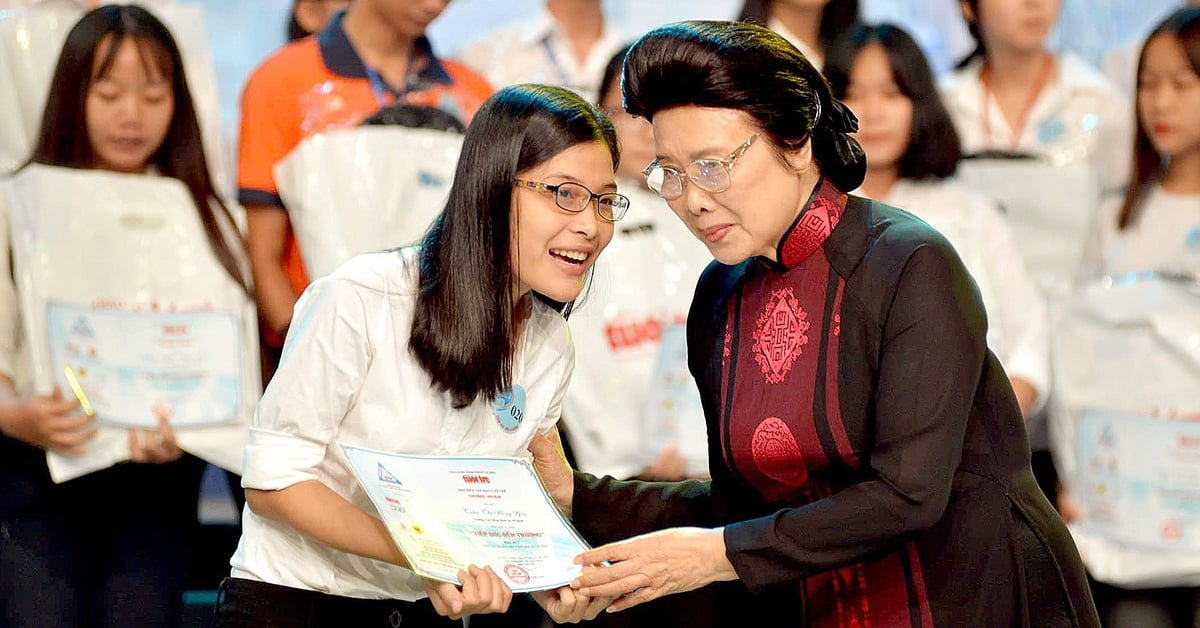Health experts warn that in 2024 there is a high risk of a measles outbreak occurring every 4-5 years, similar to 2014 and 2019 when the number of cases increased significantly.
Risk of measles outbreak
A report from the Hanoi Center for Disease Control (CDC) shows that in 2014, the city had 1,741 measles cases, and in 2019, there were 1,765 cases.
Notably, in 2014, more than 110 children died from measles. Meanwhile, from 2020 to 2023, measles cases were recorded sporadically: in 2020, there were 15 cases, in 2021, there were 2 cases, in 2022, there were 1 case, and in 2023, there were no cases.
In 2024, in the first 6 months of the year, the whole city had only 2 measles cases; but from the end of September to the beginning of October 2024, 4 to 7 measles cases were recorded per week.
 |
| Health experts warn that in 2024 there is a high risk of a measles outbreak occurring every 4-5 years, similar to 2014 and 2019 when the number of cases increased significantly. |
Faced with the above reality, Deputy Director of CDC Hanoi Khong Minh Tuan assessed that at present, the number of measles cases has begun to increase.
Patients were recorded sporadically across the city, mainly in young children who were not old enough to be vaccinated or had not been fully vaccinated. It is forecasted that in the coming time, more cases of the disease may continue to be recorded, especially in the last 3 months of the year.
According to the World Health Organization (WHO), in 1980, before the measles vaccine was widely used, nearly 2.6 million people died each year. The measles vaccine has been used for the past 50 years and has been proven to be safe, effective, and inexpensive.
During the period 2000-2012, measles vaccination helped reduce deaths by 78% worldwide. However, in Vietnam, the impact of the Covid-19 pandemic and the disruption of vaccine supply in the expanded immunization program in 2023 have affected the vaccination rate for children nationwide. Many children have not been vaccinated on schedule or have not received enough doses of vaccines, which is a risk factor for disease outbreaks, including measles.
To protect the community from measles, the community immunity rate must reach over 95%. However, records in Ho Chi Minh City - the locality that has just officially announced a measles epidemic in the whole city (late August 2024) show that, by the end of May 2024, the measles vaccination coverage rate of children born from 2019 to 2023 in Ho Chi Minh City has not reached 95%.
Recently, Ho Chi Minh City has recorded a measles outbreak, including 3 deaths. Therefore, since August 31, Ho Chi Minh City has launched a measles vaccination campaign for children from 1 to 10 years old. Up to now, the measles vaccination campaign in this locality has reached 98% of the plan.
In Hanoi, to proactively prevent the spread and outbreak of measles, from October 14, the city launched a measles vaccination campaign for children aged 1 to 5 years old and organized catch-up vaccinations for cases of delayed vaccination until November 15, 2024.
Deputy Director of the Hanoi Department of Health Vu Cao Cuong said that the campaign's goal is that over 95% of children from 1 to 5 years old living and studying in the capital who have not been fully vaccinated with measles-containing vaccines as prescribed will be vaccinated with 1 dose of measles-rubella (MR) vaccine.
Along with the vaccination campaign, the Hanoi Department of Health also directed relevant units to strengthen surveillance and early detection of measles cases in the community and medical examination and treatment facilities. In addition, units implemented measures to thoroughly handle the outbreak as soon as the first case was detected to minimize the risk of spreading and outbreaks of measles in the coming time.
New life for children after liver transplant
With 66 pediatric liver transplants, including 48 cases of complete technical autonomy, the National Children's Hospital is currently the unit with the largest number of pediatric liver transplants in Vietnam, bringing much hope to children with serious diseases such as congenital biliary atresia, liver failure, liver cancer, etc.
New life after liver transplant At the National Children's Hospital, many complicated cases such as liver transplants for blood group incompatibility, genetic diseases, especially liver transplants for low-weight children, etc. have been successfully performed over the years. Seeing the children healthy after liver transplants is the boundless happiness of parents and doctors.
4 years ago, baby HA (6 years old, in Hanoi) underwent a major liver transplant surgery to have a healthy and happy life with her family like now.
At birth, baby HA was as healthy as any other normal child. However, when he was over 1 month old, his family was shocked to learn that he had congenital biliary atresia. The progression of biliary cirrhosis later caused him to have multiple gastrointestinal bleedings, endangering his life.
Faced with that situation, doctors at the National Children's Hospital consulted and prescribed a liver transplant for HA, which was the only way to save the child's life.
Fortunately, after conducting tests, baby HA's mother had the appropriate indicators to donate a liver to her child. The difficult parallel surgery to transplant the mother's liver to HA, conducted by doctors and nurses in February 2020, was a great success, and baby HA was saved.
During the follow-up visit at the end of September 2024, HA's mother shared that baby HA is healthy, all liver functions are working normally, the baby goes to school and plays like other normal children.
"At the time my child had a liver transplant, the line between life and death was very fragile, because at that time my child's health was very poor. If it weren't for the doctors and nurses who saved him, he wouldn't be who he is today," HA's mother emotionally confided.
Associate Professor, Dr. Pham Duy Hien, Deputy Director of the National Children's Hospital, said that children with end-stage liver disease have many different causes. For people with liver disease at this stage, treatment methods are very ineffective, most of which have a high risk of death. Liver transplantation is the only way to save the child's life.
Due to the anatomical characteristics of immature and incomplete pediatric patients, the vascular structure of children is very small and easily traumatized, so liver transplantation techniques for children not only require the level and skills of surgeons but also require perseverance and determination.
From 2025, the National Children's Hospital will implement pediatric liver transplant techniques. Professor, Doctor Nguyen Thanh Liem is the one who guides and lays the foundation with the support of foreign experts.
In early 2021, doctors and nurses at the National Children's Hospital received liver transplant techniques from the 108 Military Central Hospital. After approaching and coordinating each part of the technical process with domestic and foreign experts, in March 2022, the hospital mastered the entire technical process of liver transplants for children.
Since the first liver transplant performed in 2005, the hospital has successfully performed 66 liver transplants, including 48 cases where the hospital is completely autonomous in terms of technique. The National Children's Hospital is currently the unit with the largest number of pediatric liver transplants in Vietnam.
Among the transplant cases at the hospital, most were children. The youngest patient to receive a liver transplant at the hospital was a 9-month-old baby, along with the patient with the lowest weight (5.6 kg). To this day, the record for the youngest and lowest-weight liver transplant patient in Vietnam is still held.
Associate Professor, Dr. Pham Duy Hien shared that up to now, most liver transplants at the hospital have had good results, the 5-year survival rate of children after liver transplant is more than 90%. The health of children after transplant is improving, the function of the graft is gradually stabilizing, there are cases where children after liver transplant do not need to take anti-rejection drugs.
Thanks to that, more and more children are being revived thanks to the determination of the medical team at the National Children's Hospital and the love of their families and relatives who donated part of their liver to save their children's lives.
Associate Professor, Doctor Tran Minh Dien, Director of the National Children's Hospital, added that liver and biliary diseases are one of the groups of diseases that doctors are struggling to best treat for children.
Liver transplantation is the only method to bring life as well as prolong life and improve the quality of life for patients.
However, performing liver transplants for children today still faces many challenges. First of all, there is a shortage of transplant organs and the cost of liver transplants is still high. At the same time, after liver transplant, patients must also take expensive anti-rejection drugs, which many families cannot afford.
The leaders of the National Children's Hospital hope to receive more support and companionship from agencies and organizations so that more and more children can receive liver transplants and be revived.
Advances in interventional cardiology
In recent years, the cardiovascular field in Vietnam in general and interventional cardiology in particular have made great strides, deeply integrating with the world and successfully applying many advanced techniques, comparable to developed countries in the region and globally. All cardiovascular diseases can be diagnosed and treated quickly and effectively in the country.
This has given patients the opportunity to access modern scientific achievements right in Vietnam without having to go abroad.
Professor, Dr. Nguyen Lan Viet, Permanent Vice President of the Vietnam Cardiology Association, shared that since the first coronary artery intervention performed at the Vietnam Heart Institute (in 1995), the country now has more than 140 cardiovascular intervention units with a team of nearly 500 interventional doctors.
Most provinces and cities have had interventional cardiology and patients have benefited locally, especially patients with acute myocardial infarction who have received timely, on-site intervention.
Doctors quickly access, apply and develop advanced techniques in this field in the world in Vietnam.
In the past two years, the number of cases requiring cardiovascular intervention in Vietnam has increased by nearly 20% compared to previous years, especially cases of acute myocardial infarction and coronary artery disease.
Currently, it is estimated that more than 1.3 million Vietnamese people are living with coronary artery disease, and each year, nearly 100,000 patients undergo interventional cardiovascular procedures, including 40 to 50,000 coronary stent placement interventions.
In addition, the number of patients receiving intervention for other cardiovascular diseases is also increasing rapidly, such as rhythm intervention, intervention for structural heart disease, intervention for large blood vessels and peripheral blood vessels, etc.
Notably, there are 6 centers in Vietnam that have been internationally certified as independent centers for transcatheter aortic valve replacement, of which 2 centers have become training centers for this technique. This also demonstrates the strong integration and development of interventional cardiology in our country.
However, we still have certain challenges and gaps between central and local levels as well as gaps with advanced healthcare systems in the context of rapidly advancing science.
To continuously improve the quality of cardiovascular health care, doctors need to continuously learn and improve from the valuable experiences of developed countries, update and apply the latest medical advances, share experiences among domestic colleagues, and with international colleagues. And scientific associations are one of the very good opportunities to do that.
Source: https://baodautu.vn/tin-moi-y-te-ngay-1210-ngan-dich-soi-lay-lan-d227270.html




![[Photo] Phuc Tho mulberry season – Sweet fruit from green agriculture](https://vstatic.vietnam.vn/vietnam/resource/IMAGE/2025/4/10/1710a51d63c84a5a92de1b9b4caaf3e5)
![[Photo] Unique folk games at Chuong Village Festival](https://vstatic.vietnam.vn/vietnam/resource/IMAGE/2025/4/10/cff805a06fdd443b9474c017f98075a4)

![[Photo] Prime Minister Pham Minh Chinh chairs meeting to discuss tax solutions for Vietnam's import and export goods](https://vstatic.vietnam.vn/vietnam/resource/IMAGE/2025/4/10/19b9ed81ca2940b79fb8a0b9ccef539a)

























































































Comment (0)